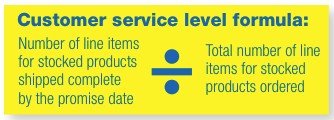Jon Schreibfeder: Effective analysis of your inventory investment
Customer service levels and stock-outs are two ratios that will help you measure and maintain successful stock levels.
 By Jon Schreibfeder, STAFDA
By Jon Schreibfeder, STAFDA
In this challenging economy, many companies are taking drastic steps to reduce their inventories. While it is important in an “uncertain” economy to keep the money you have invested in stock as low as possible, to be successful we also must continue to provide good service to our customers. That is, to meet or exceed their expectations of product availability.
In the next several articles we will explore metrics you can utilize to see how well you are satisfying your customers’ needs and at the same time be sure that you are as profitable as possible. This month we will focus on two measurements that will help you measure your success in meeting or exceeding customers’ expectations of product availability. Next month, we will explore profitability measurements.
CUSTOMER SERVICE LEVEL
The customer service level measures how often you have the items you’ve committed to stock when your customers want them. If you don’t have what your customers want, they must look for it elsewhere. Your competitors won’t have to make sales calls — your customers will seek them out!
The customer service level is calculated with the following formula:

Notice that we measure line items shipped complete. That is, when the entire quantity ordered is delivered, in one shipment, on or before the promise date listed on the order. If the customer orders 10 and we ship 10, we get credit towards the customer service level.
But, if the customer orders 25 and we only ship 24 before the promise date, we get no credit. This is truly a pass-fail test. Why no partial credit for shipping 24 out of 25? Well, if the customer wanted 24, he or she would have ordered 24. They want 25! That customer has to find that last one somewhere else; probably at your competitor’s warehouse.
Why no credit if we deliver the quantity in more than one shipment? Your customer has to process multiple stock receipts and your firm has to process multiple shipments. Both parties incur additional costs.
When calculating your customer service level, we only include sales of stocked items that are filled using warehouse inventory. We don’t include sales of other kinds of products such as:
- Special order items - Items that you do not keep on hand, but are specially ordered to fill a specific customer order.
- Direct or “drop” shipments - Material sent directly from a vendor to your customer.
Shipments of these types of items do not reflect how well you stock material to meet your customer’s immediate needs. Companies that include special order items and direct shipments when calculating a customer service level tend to overstate how well they are serving their customers from warehouse inventory.
The customer service level should be measured each month for each product, product rank, vendor line, and warehouse. You should probably strive to achieve an overall customer service level of about 95 percent. That is, 95 times out of 100, you can deliver the total quantity of the stock item ordered by the customer.
Why not 100 percent? Because the five percent of customer requests that you can’t fill from inventory are usually comprised of unusual requests for the item.
Perhaps you sell on average 500 pieces of a product each month and a customer requests 2,500 pieces. Should you have enough stock on hand to completely fill this order? Usually not. You probably couldn’t afford to maintain a five-month supply of every inventory item.
However, you may want to maintain an unusually large stock quantity of a few specific items that your customers always expect you to have in stock. These are what my mentor, the late Alan “Buddy” Silver referred to as painful backorder items.
RECORDING OUT OF STOCK SITUATIONS
The customer service level is a great measurement but it is dependent on two factors that are sometimes hard to control:
- Salespeople will accurately record the promise date for each line item on a customer order
- All customer requests for products will be accurately recorded.
One of our clients had salespeople who continually defaulted the promise date on every customer order to the current date even though the firm delivered most orders the next day. Because most orders were delivered after the recorded promise date, their computer system considered nearly every line item late and reported a very low customer service level even though deliveries generally met customers’ expectations.
At another distributor, customer requests for products that were completely out of stock were not recorded. If a customer ordered 10 pieces and one piece was shipped in the first shipment, the transaction negatively affected the customer service level. But if the item was completely out of stock and no order was entered, there was no effect on the customer service level.
To avoid these problems, some distributors measure stockouts as an alternative to the customer service level. A stockout occurs when the available quantity of a product (on-hand quantity minus quantity committed on current orders) falls to or below zero. When this occurs:
- The number of stockouts for the product is incremented by one
- The date of the stockout is recorded
When a stock receipt for the product is entered into the computer system and the available quantity rises above zero, the date of the end of the stockout is noted and a “days out of stock” for the current month is incremented by the length of the stockout.
It is imperative that both the number of stockouts and days out of stock are recorded each month for each stocked item because they tend to identify two very
different problems:
Number of stockouts: If a popular “A” ranked product experiences many stockouts (e.g., more than two in a four month period) it probably means that its normal reorder quantity is too small. All or most of each replenishment shipment is used to fill orders backorders that have accumulated during the lead time.
The standard reorder quantity of the product needs to be increased to satisfy customer demand between the receipts of replenishment shipments.
Days out of stock: A situation where the number of stockouts is low but an item has been out of stock for a significant number of days within the past several months (e.g., 14 days within a four month period) usually is the result of an
inconsistent lead time or other vendor problem.
Some distributors consider an item to be out of stock when the available quantity drops below the average or typical order quantity. For example, if customers normally order a dozen of a fastener at a time, having only one or two pieces on the shelf may be the equivalent of having none.
ANALYZING CUSTOMER SERVICE LEVEL AND STOCKOUTS
The best practice is to analyze either customer service level or stock out analysis each month using several criteria including:
Rank of Product – “A” ranked products usually make up either 80 percent of product requests or cost of goods sold. These are the products that customers request most often and provide the greatest opportunity for profit and inventory turnover. Your sales staff is embarrassed if they are not readily available. As a result they should almost always be in stock.
Even though your overall service level goal maybe 95 percent, the standard for “A” ranked products should probably be higher. Best practice is to carefully examine the replenishment parameters of any “A” ranked product that has a service level of less than 98 percent or has had more than one stockout within the past 60 days. Lower ranked “C” ranked products (typically responsible for the last 5 percent of activity) might have a service level goal of about 90 percent, to result in an overall customer service level of 95 percent.
Vendor – Is your customer service level for specific vendors’ products unacceptably low? Or are many of their products out of stock for prolonged periods of time? Can you work with these vendors to provide more consistent deliveries and improved product availability?
Buyer – Some buyers are more talented than others. The customer service level and stockout analysis are good objective measurements of a buyer’s performance.
The customer service level and stockout analysis allow you to determine how well you are achieving the first part of our goal of inventory management. That is “to meet or exceed customers’ expectations of product availability.”
In our next article we will explore some measurements that gauge your success in meeting the second part of our goal: “determining the amount of inventory that will maximize your company’s net profits or cash flow.” CS
Jon Schreibfeder is president of Effective Inventory Management, Inc. He has authored numerous articles and several books on inventory management best practices and is the designated inventory management consultant for STAFDA.
Jon can be reached by phone at 972-304-3325 or by e-mail at info@effectiveinventory.com.















